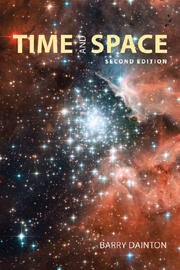Book contents
- Frontmatter
- Contents
- Preface to the second edition
- Preface to the first edition
- 1 Preliminaries
- 2 McTaggart on time's unreality
- 3 The Block universe
- 4 Asymmetries within time
- 5 Tensed time
- 6 Dynamic time
- 7 Time and consciousness
- 8 Time travel
- 9 Conceptions of void
- 10 Space: the classical debate
- 11 Absolute motion
- 12 Motion in spacetime
- 13 Curved space
- 14 Tangible space
- 15 Spatial anti-realism
- 16 Zeno and the continuum I
- 17 Zeno and the continuum II
- 18 Special relativity
- 19 Relativity and reality
- 20 General relativity
- 21 Spacetime metaphysics
- 22 Strings
- Notes
- Glossary
- Web resources
- Bibliography
- Index
9 - Conceptions of void
- Frontmatter
- Contents
- Preface to the second edition
- Preface to the first edition
- 1 Preliminaries
- 2 McTaggart on time's unreality
- 3 The Block universe
- 4 Asymmetries within time
- 5 Tensed time
- 6 Dynamic time
- 7 Time and consciousness
- 8 Time travel
- 9 Conceptions of void
- 10 Space: the classical debate
- 11 Absolute motion
- 12 Motion in spacetime
- 13 Curved space
- 14 Tangible space
- 15 Spatial anti-realism
- 16 Zeno and the continuum I
- 17 Zeno and the continuum II
- 18 Special relativity
- 19 Relativity and reality
- 20 General relativity
- 21 Spacetime metaphysics
- 22 Strings
- Notes
- Glossary
- Web resources
- Bibliography
- Index
Summary
As I mentioned at the outset, there are various metaphysical issues connected with space: structure at the very small and very large scales, dimensionality, uniqueness, topology and geometry. But, as with time, I am going to concentrate on a single central topic: is the substantival view of space correct, or is the relational view correct? Is space an object in its own right, in addition to the material bodies that occupy it, or does it consist of a network of relations between material bodies?
This question is quite unlike that of the passage of time. We could make a good deal of progress on the latter without considering what science has to say; purely meta physical considerations ruled out some models of time and empirical facts concerning experience ruled out others. The existence of space is different; purely metaphysical considerations don't get one very far, and little that is relevant can be gleaned from considering the structure of our experience. Scientific considerations will thus be entering the scene very quickly. In this preliminary survey I will set the stage by distinguishing some very general ways of thinking of space, a discussion that will yield some general constraints on a satisfactory account of it. I will then try to clarify the substantivalist and relationist views.
Space as void
For many of us these days, a conception of space that has considerable intuitive appeal runs thus: space is an infinite expanse of featureless emptiness within which physical bodies are located and move.
Information
- Type
- Chapter
- Information
- Time and Space , pp. 145 - 163Publisher: Acumen PublishingPrint publication year: 2010
